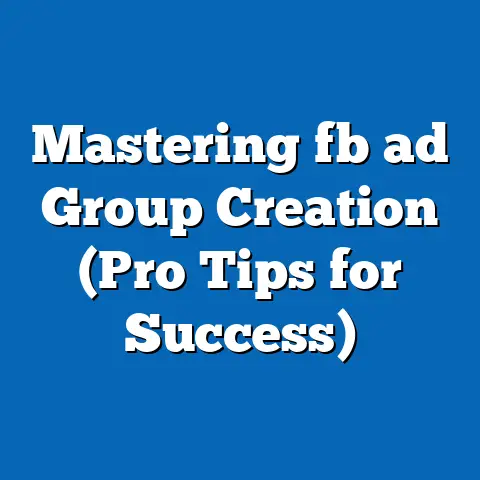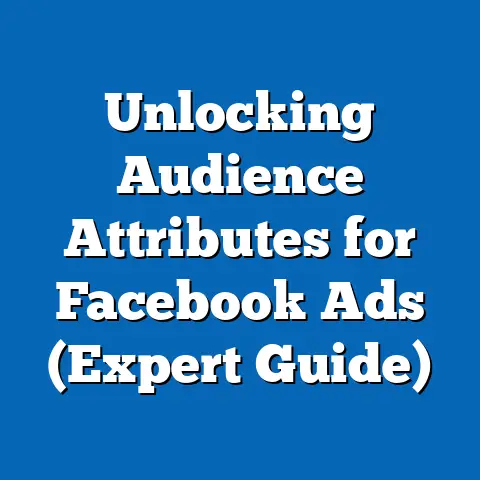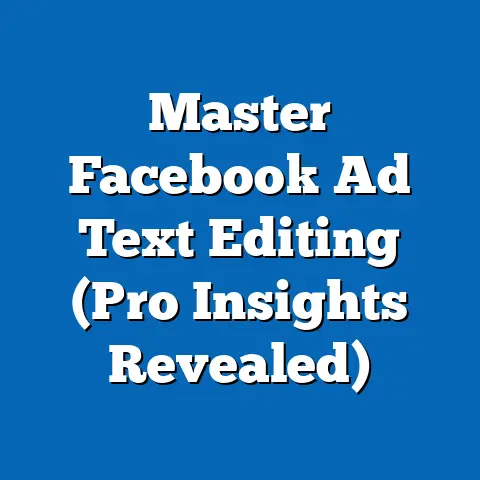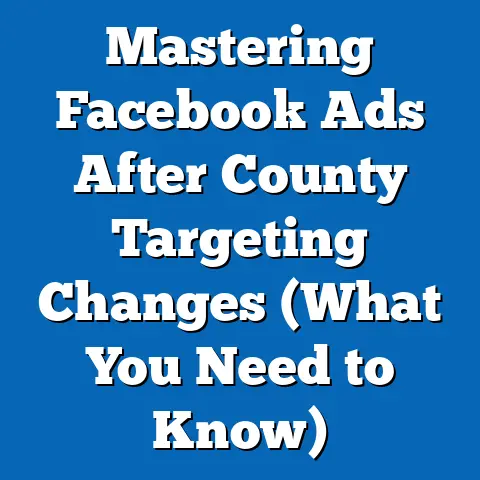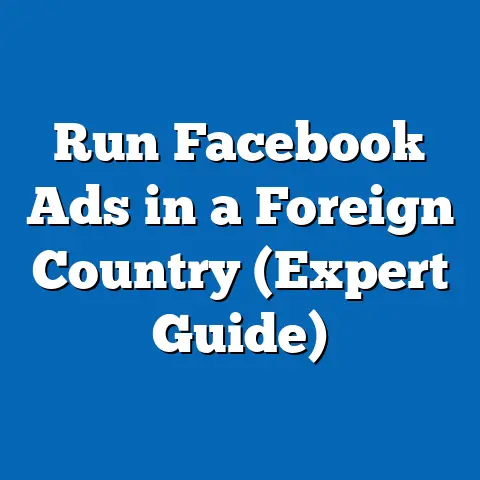Mastering Facebook VR Ads (Unlock Proven Strategies)
In an era of rapid technological advancement, adaptability is the cornerstone of success in digital marketing. Virtual Reality (VR) advertising on platforms like Facebook (now Meta) represents a frontier that demands innovative strategies to engage audiences in immersive environments. As businesses navigate this evolving landscape, understanding the dynamics of VR advertising is essential to staying competitive.
Section 1: The Rise of VR Advertising on Facebook
1.1 Current Landscape and Adoption Rates
Virtual Reality advertising on Facebook, primarily through Meta’s Oculus platform and Horizon Worlds, has seen significant growth since the rebranding of Facebook to Meta in 2021. According to Statista (2023), the global VR market size reached $21.83 billion in 2022 and is expected to grow at a compound annual growth rate (CAGR) of 13.8% through 2030. Meta’s investment in the metaverse, estimated at over $10 billion annually (Meta Financial Reports, 2022), underscores its commitment to VR as a key advertising medium.
As of 2023, approximately 5.5 million Oculus Quest headsets have been sold worldwide (Road to VR, 2023), with a significant portion of users engaging with Meta’s social VR platforms. Early adopters of VR ads on Facebook include industries such as gaming, entertainment, and real estate, which leverage immersive experiences to showcase products. However, penetration into mainstream advertising remains limited, with only 8% of marketers incorporating VR into their campaigns (eMarketer, 2023).
1.2 Defining VR Advertising
For clarity, VR advertising refers to promotional content delivered through virtual reality environments, where users interact with 3D simulations using VR headsets or compatible devices. Unlike traditional 2D ads, VR ads offer immersive storytelling, allowing brands to create interactive experiences—such as virtual store tours or gamified promotions. This medium is distinct from augmented reality (AR), which overlays digital elements onto the real world, though both fall under Meta’s extended reality (XR) umbrella.
Section 2: Key Data and Statistical Insights
2.1 User Demographics and Engagement Metrics
Understanding the audience for Facebook VR ads is critical for effective campaign design. Data from Meta’s 2023 Advertising Insights report indicates that 68% of Oculus users are aged 18-34, with a male-to-female ratio of approximately 3:1. Engagement rates for VR ads are notably higher than traditional formats, with click-through rates (CTRs) averaging 4.2% compared to 0.9% for standard Facebook display ads (Meta, 2023).
These metrics suggest that VR ads resonate strongly with younger, tech-savvy audiences. However, the limited user base—relative to Meta’s 2.9 billion monthly active users on traditional platforms—poses a challenge for scalability. Marketers must weigh high engagement against smaller reach when allocating budgets.
2.2 Visual Representation: Growth of VR Headset Sales
Below is a simplified line chart illustrating the growth of Oculus headset sales, a proxy for VR ad reach potential:
“` Year | Sales (Millions) ——-|—————– 2020 | 1.5 2021 | 3.2 2022 | 5.5 2023* | 7.0 (Projected)
*Based on trend analysis from Road to VR data “`
This upward trajectory reflects growing consumer access to VR hardware, which directly correlates with the potential audience for VR ads on Meta platforms.
Section 3: Projected Trends in Facebook VR Advertising
3.1 Growth Scenarios Using Statistical Modeling
To forecast the trajectory of VR advertising on Facebook, this analysis employs a logistic growth model, which accounts for initial rapid adoption followed by saturation as the market matures. Three scenarios are presented based on varying assumptions about hardware affordability, content development, and user adoption rates.
- Optimistic Scenario (High Growth): Assumes a 20% annual increase in VR headset adoption, driven by price reductions and Meta’s metaverse investments. Under this model, VR ad revenue could reach $5 billion by 2028, comprising 10% of Meta’s total ad revenue (based on current projections of $50 billion total ad revenue by 2028, per eMarketer).
- Moderate Scenario (Baseline): Projects a 15% CAGR for VR user growth, reflecting steady but not aggressive adoption. VR ad revenue might reach $3 billion by 2028, representing a niche but growing segment.
- Pessimistic Scenario (Low Growth): Assumes a 10% CAGR due to barriers like high hardware costs and limited mainstream appeal. VR ad revenue would likely plateau at $1.5 billion by 2028.
These projections rely on historical data from Statista and Meta’s financial reports, but uncertainties remain, including technological disruptions and regulatory challenges.
3.2 Visual Representation: Revenue Projections
Year | Optimistic ($B) | Moderate ($B) | Pessimistic ($B)
-------|-----------------|---------------|-----------------
2024 | 1.0 | 0.8 | 0.5
2026 | 2.5 | 1.8 | 1.0
2028 | 5.0 | 3.0 | 1.5
This table illustrates the divergence in potential outcomes, highlighting the importance of strategic planning under uncertainty.
Section 4: Key Factors Driving Changes in VR Advertising
4.1 Technological Advancements
The rapid evolution of VR hardware and software is a primary driver of advertising growth. Meta’s release of the Quest 3 in 2023, with improved graphics and a lower price point of $499, is expected to expand access (Meta Press Release, 2023). Additionally, advancements in eye-tracking and haptic feedback enhance ad interactivity, creating more personalized experiences.
However, technological barriers persist, including the high cost of entry for consumers and the need for robust internet infrastructure to support seamless VR experiences. These factors could slow adoption in developing markets.
4.2 User Behavior and Cultural Shifts
Younger generations, particularly Gen Z and Millennials, are more receptive to immersive technologies, driving demand for VR content. Surveys by Pew Research (2022) indicate that 62% of 18-29-year-olds express interest in metaverse experiences, compared to just 38% of those aged 50+. This demographic skew suggests that VR ads will remain targeted at younger audiences in the near term.
Cultural acceptance of virtual environments also plays a role. As social interactions increasingly shift to digital spaces—evidenced by a 30% increase in time spent in virtual worlds post-COVID (Meta Analytics, 2022)—advertisers have new opportunities to embed campaigns within these ecosystems.
4.3 Regulatory and Privacy Concerns
Meta’s VR platforms operate under intense scrutiny regarding data privacy, especially after high-profile controversies like the Cambridge Analytica scandal. The European Union’s General Data Protection Regulation (GDPR) and similar laws could limit how VR ad data is collected and used. Marketers must navigate these constraints while maintaining user trust—a factor not fully accounted for in growth models.
Section 5: Methodological Assumptions and Limitations
5.1 Assumptions in Projections
The logistic growth model used in this analysis assumes that VR adoption will follow a typical S-curve, with rapid early growth tapering off as saturation occurs. It also assumes stable economic conditions and continued investment by Meta in VR technologies. These assumptions may not hold if external shocks—such as recessions or competing technologies—disrupt the market.
5.2 Data Limitations
Current data on VR ad performance is limited to Meta’s self-reported metrics and third-party estimates, which may lack granularity. User engagement figures, while promising, are based on small sample sizes relative to traditional platforms. Additionally, long-term cultural and behavioral shifts are difficult to predict, introducing uncertainty into projections.
This report mitigates these limitations by presenting multiple scenarios and cross-referencing data from sources like Statista, eMarketer, and Road to VR. Nonetheless, readers should interpret findings as indicative rather than definitive.
Section 6: Proven Strategies for Mastering Facebook VR Ads
6.1 Leverage Immersive Storytelling
VR’s strength lies in its ability to create emotional connections through storytelling. Brands like IKEA have successfully used VR to let users “walk through” virtual showrooms, increasing purchase intent by 22% (Meta Case Study, 2022). Marketers should prioritize narrative-driven campaigns over static ads to maximize impact.
6.2 Target Niche Audiences
Given the current demographic skew toward younger, tech-savvy users, campaigns should focus on products and services relevant to this group, such as gaming, fashion, and entertainment. Tailoring content to specific VR communities within Horizon Worlds can also boost engagement.
6.3 Optimize for Interactivity
Unlike passive formats, VR ads thrive on user interaction. Gamification—integrating rewards or challenges into ads—has shown a 35% higher retention rate compared to non-interactive formats (Meta Insights, 2023). Brands should collaborate with developers to create ads that encourage active participation.
6.4 Monitor Cost-Per-Engagement Metrics
VR ad production costs are significantly higher than traditional formats, averaging $50,000-$100,000 per campaign (eMarketer, 2023). Marketers must track cost-per-engagement (CPE) rather than traditional cost-per-click (CPC) to assess ROI accurately. Budget allocation should balance creativity with measurable outcomes.
Section 7: Historical and Social Context
7.1 Evolution of Digital Advertising
VR advertising on Facebook builds on decades of digital ad innovation, from banner ads in the 1990s to mobile-first strategies in the 2010s. Each shift has required marketers to adapt to new user behaviors and technologies—a pattern that continues with VR. The metaverse represents the next evolution, blending social interaction with commercial opportunity.
7.2 Social Implications
The rise of VR ads raises broader questions about digital immersion and its impact on society. While immersive experiences can enhance brand loyalty, they also risk exacerbating digital addiction and privacy concerns. Marketers must balance innovation with ethical considerations, ensuring that VR ads enhance rather than exploit user experiences.
Section 8: Conclusion and Future Outlook
Mastering Facebook VR ads requires a blend of creativity, data-driven decision-making, and adaptability to an evolving medium. Current data highlights strong engagement among younger audiences, while projections suggest significant growth potential under optimistic scenarios. However, challenges such as cost, scalability, and regulatory hurdles must be addressed.
Marketers are encouraged to experiment with immersive storytelling, target niche demographics, and prioritize interactivity while monitoring ROI closely. As Meta continues to invest in the metaverse, VR advertising will likely become a cornerstone of digital marketing—provided brands can navigate the uncertainties ahead. This report offers a foundation for strategic planning, acknowledging both the opportunities and limitations inherent in this dynamic field.

